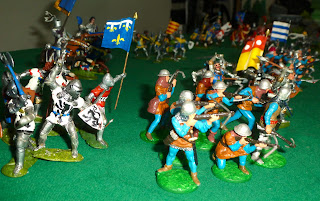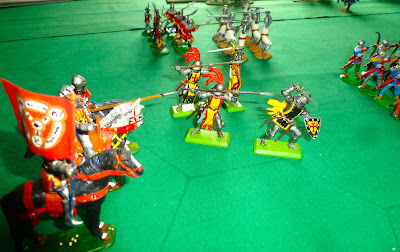Our first trial game of Lionheart worked very well so we decided to expand on it by introducing some terrain elements and and an additional two unit types; Heavy Foot Knights and Mercenaries. The remainder of the armies were the same as in our previous game and we increased the number of actions in each turn from four to six per side. The basic game mechanics were explained in my previous post HERE.
When I have a little money, I buy Toy Soldiers; and if I have any left, I buy food and clothes. (with apologies to:) ERASMUS
Showing posts with label Lionheart. Show all posts
Showing posts with label Lionheart. Show all posts
Wednesday, 21 May 2025
Lionheart - more playing with old toy knights.
The French line up with Heavy Foot Knights on the left flank (just visible at the top of the pic) and the Kievan Mercenaries on the extreme right. For the Mercenaries we used Medieval Russian Knights made in china by Supreme along with some made in Russia by Engineer Basevitch.
While the English line advances with Heavy Foot to the front (Britains Deetail knights just beyond the Timpo Crusaders) and Irish Mercenaries with their priest following in support.
The game allows for one more unit type; Peasants, but I didn't have any suitable figures to hand so we left them out, maybe they'll appear next time.
With their enhanced mobility it's always difficult to hold back the Mounted Knights, they charge across the field when they see an opportunity to strike. This invariably draws out their opposite counterparts and leads to a duel between the chivalry.
The Mercenaries are strong in combat and have the ability to induce panic in any unit they attack, forcing them to retire, the danger is that they can be turned if they come in contact with the enemy King and may change sides.
The terrain comprised a line of hills with a road running through them on one flank, a central plain and a forest with a road running through it on the opposite flank. I like to keep things simple to begin with.
The Heavy Foot Knights (centre) are powerful in combat but very slow moving, it takes two actions to move them one hex, as a result they never really got into the game.
After the Mounted Knights had exhausted themselves duelling the Infantry and Archers moved in, the latter being quite vulnerable if attacked so need close support.
The Kings and their retinues tends to become a mounted reserve, kept safely out of the way behind the lines until desperation draws them out into the fray.
As things turned out all of the action took place in the central plain and virtually no use was made of the hills or forest. (Note to self: put more obstacles in the centre of the field next time)
I always pick up bits and pieces of Timpo medievals when I see them in the cheap junk boxes at shows, they invariably have no weapons, scabbards or shields but that's easily sorted. They are notoriously unstable on their small green bases so I mount them on 2p coins, this will be anathema to some people but lets face it they're not rare, you can find hundreds of them on the internet auction sites every day of the week.
This time the game was much less cohesive with small groups of opposing units engaging in clumps of combat dispersed around the field.
It's a good game system and I like the way it flows, I think we will need to give more thought to how we deploy the Heavy Foot Knights or revisit the way we allocate actions in each turn.
With a little tweaking the system could be easily adapted to the Dark Ages or brought forward into the Renaissance, so we might have a go at one of those periods sometime.
Saturday, 2 November 2024
Lionheart - a medieval wargame with 54mm toy soldiers
Lionheart is a medieval boardgame published by Parker Brothers in 1997, played on a square grid with 25mm pieces the aim is to capture the enemy King or destroy all of his army, it plays a bit like a game of chess. We thought we'd try out the basic game to see if it would translate to a wargame with 54mm toy soldiers, here's how it went:
The English left wing shown above and the right wing pictured below, the basic game has 4 unit types: The King, mounted knights (2 units), infantry (5 units) and archers (2 units). For visual impact we doubled the number of figures in each unit, so the King got a standard bearer, each mounted unit was 4 figures and foot were 8.
There is an advanced version of the game that includes 3 more unit types: heavy foot knights, peasants and mercenaries but we left these out this time as we were just looking to test the game mechanics. One major change we did make was to play on a hex grid rather than a square one but this doesn't make any significant change to the dynamics of the game.
The French left wing shown above and the right wing pictured below. Players dice to see who goes first and then play on I go U go basis, as we'd doubled the number of figures in play we also doubled the number of actions allowed each move from 2 to 4. The actions allowed are: Move, Turn, Attack and the limit of 4 actions applies across the whole army not unit by unit, actions can be taken in any order i.e. 4 units could make 1 move or alternatively 1 unit could move, a second could turn while a third moved and attacked.
All units move in a straight line, mounted (King and knights) can move any number of hex for 1 action but foot units (infantry and archers) only move 1 hex for 1 action. No interpenetration through other units is allowed.
Archers can fire over friendly units and their range is anywhere in the arc of the 9 hex in front of them (2 hex, then 3, then 4). All other units attack when they move into direct contact with an enemy unit and have an action remaining to enable the attack i.e. for an infantry unit to move 2 hex and make an attack costs 3 actions.
The game uses 6 sided dice with symbols: 3 x Axe, 2 x Arrow and 1 x Panic. We used ordinary D6 with 1,2,3 = Axe, 4,5 = Arrow and 6 = Panic. A D6 is thrown for each foot figure in a unit and 2 x D6 for each mounted, so a maximum of 8 x D6 for each unit. Archers register a hit for every Arrow thrown, all other units make a hit when an Axe is rolled, casualties are removed: foot for 1 hit and mounted for 2 hits (rounded down). Combat is completed one unit at a time and hits are not cumulative.
If 4 x Panic dice are thrown the the unit attacked must turn and retreat one move i.e. a unit of 8 infantry attacks an enemy infantry unit, it throws 8 dice and scores: 3 x Axe, 1 x Arrow and 4 x Panic, the unit attacked suffers 3 casualties then must turn and retreat.
We found the rules very quick and easy to assimilate, the game flows fast and smoothly. Foot units advance rather ponderously and need to be supportive, a unit that becomes detached is liable to be picked off and overrun by enemy cavalry. On both sides archers made up 20% of the total units, so a decent representation but not enough to dominate the field and turn the game into just another shooting match. The mounted units are very much the arme blanche of the game, sudden sweeping charges packing a devastating punch, just as it should be.
We didn't include any terrain features but there is provision for this. Going forward I think we will take scenarios from One Hour Wargames, or perhaps based on historical events and introduce the additional 3 unit types (heavy foot, peasants and mercenaries). The simplicity of the rule system and lack of any record keeping also means that we could easily double the number of units and actions per turn to make it a much bigger game. It would be interesting to try an Agincourt scenario, with the flower of French chivalry facing a wall of English archers!
Apart from the Timpo crusaders, which have been based to give them more stability on the table.
all the rest of the figures are conversions, mostly from the talented hand of modeller and heraldic expert Vince Mattocks,
Subscribe to:
Comments (Atom)




















